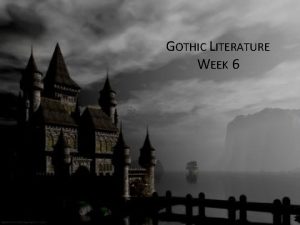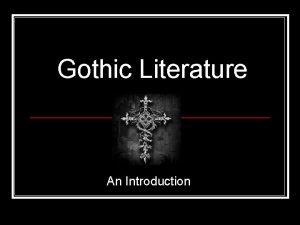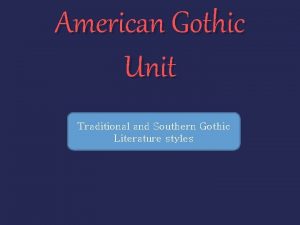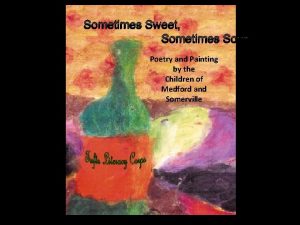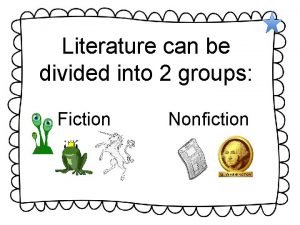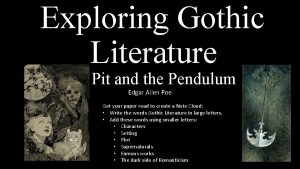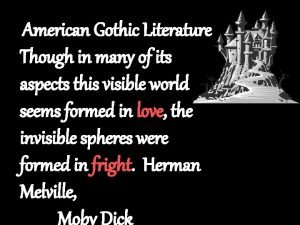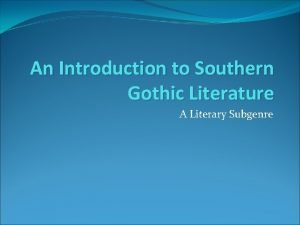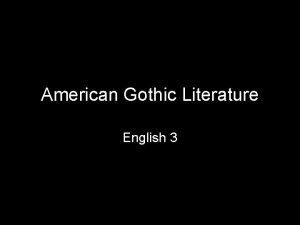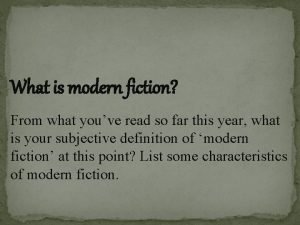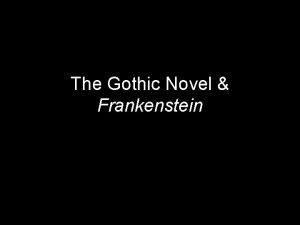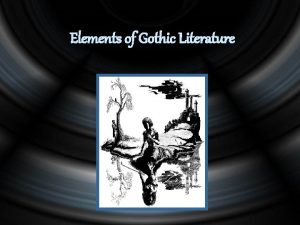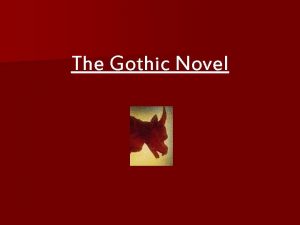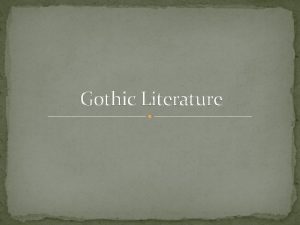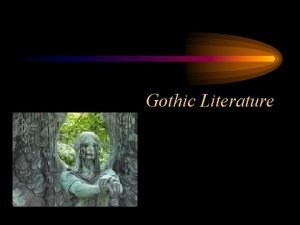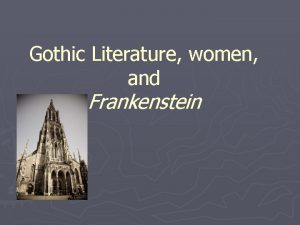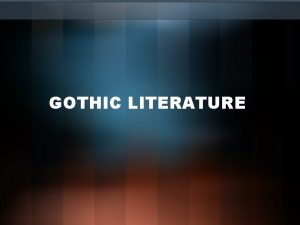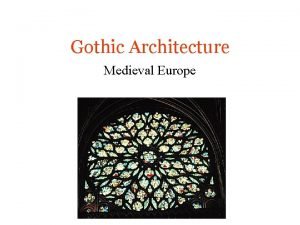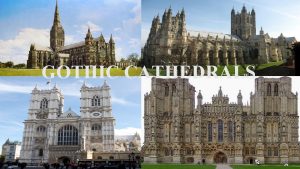GOTHIC LITERATURE WEEK 6 Definition Gothic fiction sometimes



















- Slides: 19

GOTHIC LITERATURE WEEK 6

Definition Gothic fiction (sometimes referred to as Gothic horror) is a genre of literature that combines elements of both horror and romance. As a genre, it is generally believed to have been invented by the English author Horace Walpole, with his 1764 novel The Castle of Otranto.

Purpose The gothic novel can be seen as a description of a fallen world Writers of gothic fiction were reacting to the rigidity and formality of other forms of Romantic era literature

Setting Evokes the atmosphere of horror and dread Also portrays the deterioration of its world The decaying, ruined scenery implies that at one time there was a thriving world. At one time the abbey, castle, or landscape was something treasured and appreciated. Now, all that lasts is the decaying shell of a once thriving dwelling.

Examples of Gothic Literature The Castle of Otranto ~ Horace Walpole (considered the first work of Gothic fiction) A Long Fatal Love Chase ~ Louisa May Alcott The House of the Seven Gables ~ Nathaniel Hawthorne The Mysteries of Udolpho ~ Ann Radcliffe The Italian ~ Ann Radcliffe The Woman in White ~ Wilkie Collins The Moonstone ~ Wilkie Collins The Monk ~ Matthew Gregory Lewis The Rime of the Ancient Mariner ~ Samuel Taylor Coleridge Wuthering Heights ~ Emily Bronte The Grey Woman ~ Elizabeth Gaskell The Turn of the Screw ~ Henry James Rebecca ~ Daphne du Maurier Dracula ~ Bram Stoker The Picture of Dorian Gray ~ Oscar Wilde Dr. Jekyll and Mr. Hyde ~ Robert Louis Stevenson Frankenstein ~ Mary Shelley The Phantom of the Opera ~ Gaston Leroux Any of Edgar Allen Poe's works

Characters The Gothic hero becomes a sort of archetype as we find that there is a pattern to their characterization. There is always the protagonist, usually isolated either voluntarily or involuntarily. Then there is the villain, who is the epitome of evil, either by his (usually a man) own fall from grace, or by some implicit malevolence. The Wanderer, found in many Gothic tales, is the epitome of isolation as he wanders the earth in perpetual exile, usually a form of divine punishment.

Archetypes An archetype is a universally understood symbol, term, statement, or pattern of behavior, a prototype upon which others are copied, patterned, or emulated. Archetypes are often used in myths and storytelling across different cultures.

Virginal Maiden Young, beautiful, pure, innocent, kind, virtuous. Shows these virtues by fainting and crying whenever her delicate sensibilities are challenged, usually starts out with a mysterious past and it is later revealed that she is the daughter of an aristocratic or noble family.

Maiden Examples: Matilda in The Castle of Otranto – She is determined to give up Theodore, the love of her life, for her cousin’s sake. Matilda always puts others first before herself, and always believes the best in others. Adeline in The Romance of the Forest – “Her wicked Marquis, having secretly immured Number One (his first wife), has now a new and beautiful wife, whose character, alas! Does not bear inspection. ” As this review states, the virginal maiden character is above inspection because her personality is flawless. Hers is a virtuous character whose piety and unflinching optimism causes all to fall in love with her.

Older, Foolish Woman Hippolita in The Castle of Otranto – Hippolita is depicted as the obedient wife of her tyrant husband who “would not only acquiesce with patience to divorce, but would obey, if it was his pleasure, in endeavouring to persuade Isabelle to give him her hand”. [48] This shows how weak women are portrayed as they are completely submissive, and in Hippolita’s case, even support polygamy at the expense of her own marriage. Madame La. Motte in The Romance of the Forest – naively assumes that her husband is having an affair with Adeline. Instead of addressing the situation directly, she foolishly lets her ignorance turn into pettiness and mistreatment of Adeline.

Hero Theodore in The Castle of Otranto – he is witty, and successfully challenges the tyrant, saves the virginal maid without expectations Theodore in The Romance of the Forest – saves Adeline multiple times, is virtuous, courageous and brave,

Tyrant Manfred in The Castle of Otranto – unjustly accuses Theodore of murdering Conrad. Tries to put his blame onto others. Lies about his motives for attempting to divorce his wife and marry his late son’s fiancé. The Marquis in The Romance of the Forest – attempts to get with Adeline even though he is already married, attempts to rape Adeline, blackmails Monsieur La. Motte. Although he was an eccentric man, learned in the ways of science, physics, and astrology, he loved his people. His main greed, however, was thirst for knowledge. He wanted to know everything. This is what led him on the road to damnation. ”

The Stupid Servant Acts as comic relief by asking seemingly stupid questions, transitions between scenes, brings news, messenger, moves plot forward Peter in The Romance of the Forest – whenever he brings information to people, he never gets to the point but prattles on and on about insignificant things. “The reader…eagerly follows the flight of La. Motte, also of Peter, his coachman, an attached, comic, and familiar domestic. ” Bianca in The Castle of Otranto – a gossip, helps characters get valuable news, provides comic

Clowns Break the tension and act as comic relief Diego and Jaquez in The Castle of Otranto – they appear to talk about random things, and argue foolishly with each other in order to lighten the air of the novel.

Banditti/Ruffians They appear in several Gothic Novels including The Romance of the Forest in which they kidnap Adeline from her father.

Clergy Always weak, usually evil Father Jerome in The Castle of Otranto – Jerome, though not evil, is certainly weak as he gives up his son when he is born and leaves his lover. Ambrosio in The Monk – Evil and weak, this character stoops to the lowest levels of corruption including rape and incest. Mother Superior in The Romance of the Forest – Adeline fled from this convent because the sisters weren’t allowed to see sunlight. Highly oppressive environment.

The Setting The setting of the Gothic Novel is a character in itself. The plot is usually set in a castle, an abbey, a monastery, or some other, usually religious edifice, and it is acknowledged that this building has secrets of its own.

It is this gloomy and frightening scenery, which sets the scene for what the audience should expect. The importance of setting is noted in a London review of The Castle of Otranto “He describes the country towards Otranto as desolate and bare, extensive downs covered with thyme, with occasionally the dwarf holly, the rosa marina, and lavender, stretch around like wild moorlands…Mr. Williams describes the celebrated Castle of Otranto as “an imposing object of considerable size…has a dignified and chivalric air. A fitter scene for

Similarly, De Vore states “The setting is greatly influential in Gothic novels. It not only evokes the atmosphere of horror and dread, but also portrays the deterioration of its world. The decaying, ruined scenery implies that at one time there was a thriving world. At one time the abbey, castle, or landscape was something treasured and appreciated. Now, all that lasts is the decaying shell of a once thriving dwelling. ” Thus, without the decrepit backdrop to initiate the events, the Gothic Novel would not exist.
 Meaning of gothic fiction
Meaning of gothic fiction Gothic horror definition
Gothic horror definition American gothic poem
American gothic poem Sometimes you win some
Sometimes you win some They say sometimes you win some
They say sometimes you win some Sometimes sweet
Sometimes sweet Sometimes cold sometimes hot
Sometimes cold sometimes hot It is genre of speculative fiction
It is genre of speculative fiction Elements of narrative nonfiction
Elements of narrative nonfiction Contemporary realistic fiction vs historical fiction
Contemporary realistic fiction vs historical fiction Historical story
Historical story Week by week plans for documenting children's development
Week by week plans for documenting children's development Elements of gothic fiction in the pit and the pendulum
Elements of gothic fiction in the pit and the pendulum Characteristics of gothic literature
Characteristics of gothic literature American gothic period
American gothic period Southern gothic definition
Southern gothic definition American gothic characteristics
American gothic characteristics What is modern fiction
What is modern fiction Gothic literature englightenment
Gothic literature englightenment Frankenstein as a gothic novel
Frankenstein as a gothic novel
